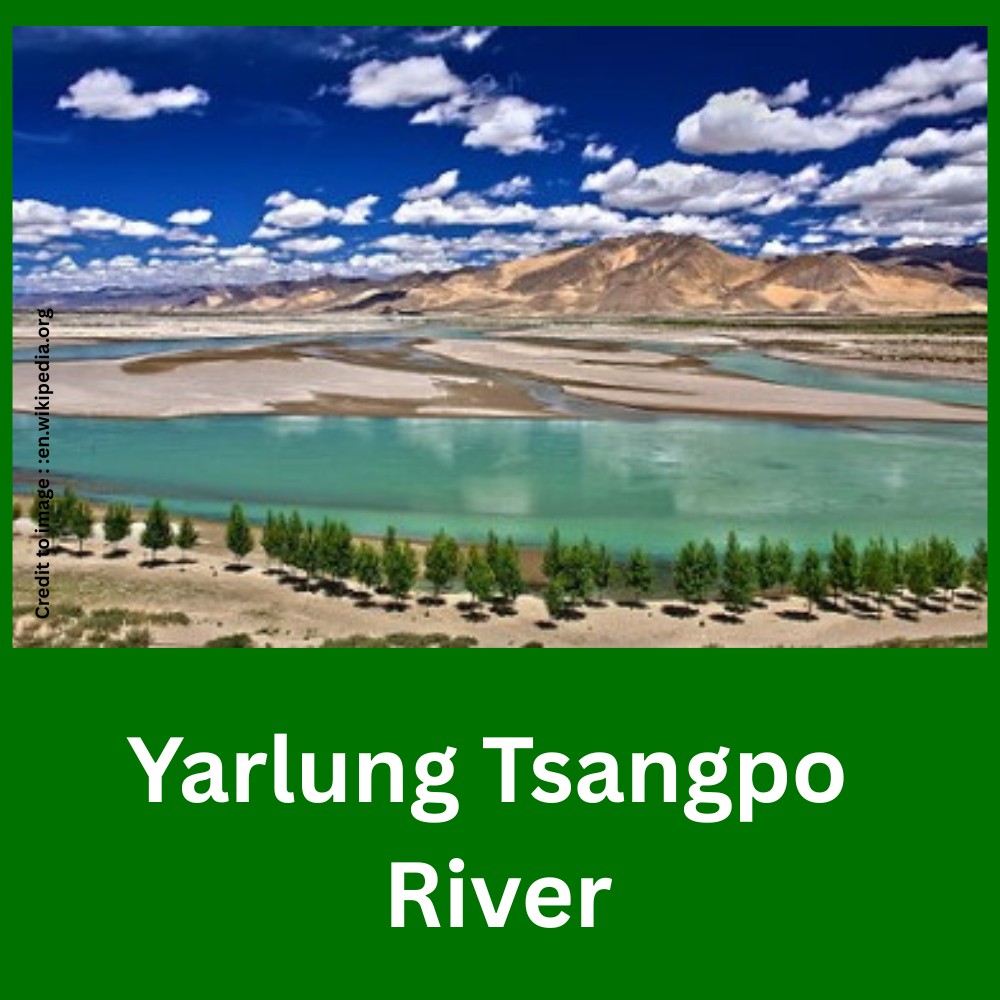The Yarlung Tsangpo River, often referred to as the highest-altitude major river in the world, is more than just a waterway—it is a lifeline for ecosystems, civilizations, and regional climate balance across the Himalayas and South Asia. Originating from the sacred Mount Kailash in Tibet, it transforms into the mighty Brahmaputra River upon entering India. With China’s recent announcement of constructing the world’s largest hydroelectric dam on this river, new ecological, geopolitical, and environmental alarms have been triggered. This article explores the ecological importance, scientific value, interconnection with the Brahmaputra, and the urgent environmental implications of this river in 2025.

Why the Yarlung Tsangpo River is in the News (2025)
China Begins Construction of the World’s Largest Hydroelectric Dam on the Yarlung Tsangpo River in Tibet
In July 2025, China officially commenced construction on what is poised to become the world’s largest hydroelectric dam on the Yarlung Tsangpo River near the Great Bend in Medog County, Tibet. The move has raised global environmental concerns, especially in India and Bangladesh, as the river flows into their territories as the Brahmaputra River. The dam project is expected to generate 60 GW of power, surpassing even the Three Gorges Dam, but it also poses grave ecological, seismic, and geopolitical risks.
Origin and Course of Yarlung Tsangpo River
| Parameter | Details |
| Origin | Angsi Glacier near Mount Kailash, Tibet |
| Country of Origin | China (Tibet Autonomous Region) |
| Length | ~2,840 kilometers |
| Elevation at Source | Approximate 5,300 meters above sea level |
| Flow Direction | West to East, then South into India |
| Confluence | Enters India as Brahmaputra River in Arunachal Pradesh |
| End Point | Bay of Bengal (via Brahmaputra and Meghna) |
Scientific Importance of Yarlung Tsangpo River (Data Table)
| Aspect | Details |
| Geological Significance or Importance of Yarlung Tsangpo River | Flows through the world’s deepest Yarlung Tsangpo Grand Canyon |
| Altitude | World’s highest major river |
| Climatic Role | Regulates monsoon and snow-melt runoff dynamics |
| Biodiversity Hotspot | Originates near Eastern Himalayan ecozone, rich in endemic flora/fauna |
| Seismic Sensitivity | Located in a highly active tectonic zone prone to landslides and earthquakes |
| Hydrological Value | Major water source for downstream agriculture in India and Bangladesh |
| Glacial Monitoring | Key indicator of Himalayan glacier retreat due to climate change |
Ecological and Environmental Importance of Yarlung Tsangpo River
- Biodiversity Support
The river basin supports rare Himalayan species like snow leopards, red pandas, and blue poppies. The moist alpine and subtropical forests along its route act as carbon sinks and pollution filters. - Sustains Indigenous Communities
Tibetan communities and later the Assamese, Arunachali, and Bangladeshi populations rely heavily on this river for drinking water, irrigation, and spiritual practices. - Hydro-Climatic Balance
It plays a vital role in regional weather patterns and balances the monsoon intensity through glacial melt and seasonal flow. - Climate Change Sentinel
With rapid glacial melting and erratic precipitation, it has become a key climate change observation zone.
Connection Between Yarlung Tsangpo and Brahmaputra Rivers
| Feature | Yarlung Tsangpo | Brahmaputra |
| Origin | Angsi Glacier, Tibet | Continuation of Yarlung Tsangpo in India |
| Country of Flow | China (Tibet) | India, Bangladesh |
| Name Change | Changes to Brahmaputra in Arunachal Pradesh | Known as Brahmaputra in India and Jamuna in Bangladesh |
| Ecological Impact | High-altitude glacial and canyon ecosystems | Plains river with vast floodplains and deltaic regions |
| Cultural Significance | Sacred in Tibetan Buddhism | Sacred in Hinduism and local tribal traditions |
Environmental Concerns of the Megadam Project on Yarlung Tsangpo
- Loss of Biodiversity: Submergence of pristine ecosystems and endangered species habitats.
- Earthquake Risk: Construction in a seismically active zone could increase landslide and quake vulnerability.
- Water Flow Disruption: Potential to reduce water availability in downstream Indian and Bangladeshi territories.
- Agricultural Impact: Risk of droughts and floods in Assam and Bengal plains.
- Geopolitical Tensions: Strains transboundary water-sharing agreements and regional diplomacy.
Summary
The Yarlung Tsangpo River is not only a scientific wonder but a lifeline for millions of people and countless species. As China pushes forward with a gigantic hydropower project. The ecological and environmental balance of South Asia is an important topic of research for Geologist and scientist and environmentalist . While power generation is vital, preserving the ecological integrity and ensuring downstream harmony is crucial for sustainable development. The river’s link to the Brahmaputra, its climatic role, and its biological richness make it a global priority for conservation and cooperation.
Frequently Asked Questions (FAQs)
1. Where does the Yarlung Tsangpo River originate?
The river originates from the Angsi Glacier near Mount Kailash in Tibet.
2. How is Yarlung Tsangpo connected to the Brahmaputra River?
The Yarlung Tsangpo becomes the Brahmaputra River as it enters Arunachal Pradesh in India.
3. Why is the Yarlung Tsangpo River scientifically important?
It flows through the deepest canyon on Earth, sits at high altitudes, and plays a key role in climate regulation.
4. What is the concern with China’s dam on the Yarlung Tsangpo?
The mega-dam project threatens biodiversity, risks seismic disasters, and could disrupt water flows to downstream countries.
5. What is the ecological role of the Yarlung Tsangpo?
It supports Himalayan biodiversity, balances hydrological cycles, and aids climate moderation.
6. How long is the Yarlung Tsangpo River?
It is approximately 2,840 km long.
7. What is the Great Bend?
A dramatic U-turn in the river’s course around Namcha Barwa Peak, where the proposed dam is being constructed.
8. Which countries are affected by this river?
Primarily China, India, and Bangladesh.
References
- NASA Earth Observatory – Himalayas and River Systems
- International Rivers. (2024). Transboundary Rivers and Hydropower Risks.
- WWF India. (2023). Brahmaputra River Ecosystem and Biodiversity.
- The Hindu. (2025). China Starts Dam Construction on Yarlung Tsangpo.
- IPCC AR6 Report. (2022). Hydrological changes in Himalayan Glacier Systems.
- Hindustan Times News
- Prakriti Darshan-Nature and Environment News
- Wikipedia
Meta Description (for SEO):
Explore the ecological, environmental, and geopolitical importance of the Yarlung Tsangpo River, its connection with the Brahmaputra River, and the controversy around China’s new hydroelectric dam in 2025.
PRAKRITI DARSHAN-NATURE AND ENVIRONMENT MAGAZINE
Prakriti Darshan is a leading Hindi-language magazine and digital platform dedicated to raising public awareness on vital issues related to nature, biodiversity, climate change, sustainable development, and environmental conservation. This magazine represents a unique blend of science, society, and sensitivity—offering a common platform for researchers, students, NGOs, policymakers, nature lovers, and conscious citizens alike.
With thought-provoking articles, inspiring stories, environmental research, impactful projects, and policy perspectives, Prakriti Darshan is a transformative journey toward a greener and more sustainable future.
Let us come together to protect and preserve our planet for generations to come. 🌿🌍
Join us in our mission to protect and celebrate the planet. 🌏💚
Click for more information
- Visit www.prakritidarshan.com for Free Magazine ,Free membership benefits ,offered price magazine @ Rs.1 or Rs.11 only and more ……
- 🎗️Sponsor Prakriti Darshan Magazine – Support our environment mission.
- 📚 Explore the Environment Magazine – Read our latest and past issues.
- ✍️ Read Editor’s Article or Blog – Insightful thoughts from our editorial desk.
- 🌱 Join Membership – Be part of India’s leading green community.
- 🤝 Become an NGO Impact Story Partner – Share your grassroots impact nationwide.
- 🏢 Become a Company Partner – Showcase your CSR, ESG, or sustainability work.
- 👤 Become an Individual Partner – Volunteer, write, and raise your green voice.
- 📢 Advertise with Us – Reach eco-conscious readers across India.
- Eco Trails Newsletter
- Donate for “Hari Ho Vashundhara & Har school Hariyali “ Plantation campaign Associated Partner NGO :GDSS NGO www.gdssngo.org
BALA DATT SHARMA,
MANAGING EDITOR ,
PRAKRITI DARSHAN-NATURE AND ENVIRONMENT MAGAZINE
- Eco Friendly Lifestyle: Practical Tips, Benefits, and Global Impact - September 7, 2025
- ISO 14001 – Global Standard for Environmental Management - September 7, 2025
- Methane and Methane Emissions from Abandoned Fossil Fuel Infrastructure: Global Data, Climate Impact, and Mitigation Strategies - September 2, 2025








